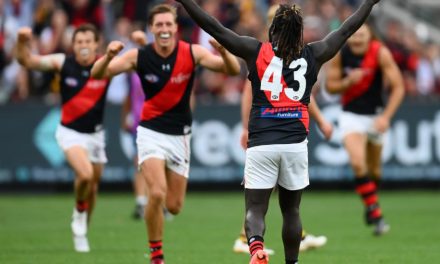Taylor Walker and his Crows have been prime examples of the unpredictability of the first month of the AFL season. Photo: GETTY IMAGES
We’re four rounds into a new AFL season, and perhaps the most important conclusion to be drawn so far is this … that you can’t draw any conclusions.
That’s great news for lovers of unpredictability in the game. But for elements of the football media, perhaps not so much. Which for us crusty old cynics constantly despairing about how standards in the fourth estate have slipped in recent times, yes, is also good news.
The “early crow” has become a depressingly familiar part of the football landscape. But I’m detecting a welcome change in 2021.
In recent years, a sample of just four games has never been too small for some clubs to be declared “in crisis”, for some coaches to be declared “under fierce pressure” to retain their posts, or for Team X to be labelled an “unbackable premiership favourite”. This year to date, though, that sort of clickbait is yet to appear.
How could it? Take a look at the AFL ladder. Only one club, North Melbourne, is yet to win a game, and the Roos led at three-quarter time on Sunday. Just three clubs remain undefeated, and two of them, Sydney and Melbourne, haven’t played finals in either of the past two seasons.
The coach of that latter side, Simon Goodwin, was the favourite subject of those pre-season “coach-in-the-hot-seat” articles. With his Demons at 4-0, you won’t see any more of them for at least the next little while.
Coach of the 0-4 team, meanwhile, David Noble, is in the first year of what North Melbourne has very transparently spoken about as a major rebuild. He has plenty of time to deliver on that. The added bonus of not being a marquee headline-grabbing football name will buy him even more.
There’s also an interesting measuring stick in the very opponent who ended up beating the Roos on Sunday. That would be Adelaide, which had racked up 16 consecutive defeats by the end of last season before it promptly won three in a row. And those same Crows are currently 3-1 and in fifth spot on the ladder, having now won six of their past eight games.
In North Melbourne’s case, lack of on-field success has usually preceded a bigger-picture “crisis” about the club’s very survival. Yes, we mean those columns about potential shifts to Tasmania.
But even continued discussion about the prospect of a Tasmanian AFL club, kicked along recently by the masterplan of a very big name, Eddie McGuire, isn’t largely being framed around North Melbourne’s possible relocation, more widespread recognition now that the Apple Isle needs a franchise genuinely of its own making, not an awkwardly-adopted son.
PLEASE HELP US CONTINUE TO THRIVE BY BECOMING AN OFFICIAL FOOTYOLOGY PATRON. JUST CLICK THIS LINK.
At the other end of the AFL ladder, meanwhile, talk of Richmond dynasties has died down a tad, the Tigers currently only 2-2 and in eighth spot.
That’s neither here nor there for the headline writers, the Tigers doing enough to register wins over two decent-enough opponents in Carlton and Hawthorn, certainly down by several degrees in a loss to Sydney, but a defeat in which the narrative focused on the exciting Swans, and then only just pipped at the post by Port Adelaide last Friday night in a game they might have won had it gone another couple of minutes.
Richmond hasn’t been so good, so we’re not seeing those hoary old “who-can-get-near-them?” pieces. And fortunately, not so bad that it’s inspired that other old chestnut, the “end of an era?” Well, not yet anyway.
Football media’s agent provocateurs were starting to get excited again last week, mind you, with the faintest scent of a crisis in their nostrils after St Kilda, a finalist last year, crashed to a second defeat in a row in an abysmal 75-point thumping against Essendon.
Indeed, that scent had arguably become a distinct aroma midway through the third quarter on Saturday afternoon when the Saints trailed West Coast by 33 points. But eight consecutive goals to St Kilda and an eventual 20-point victory snuffed it out pretty quickly.
Different clubs’ various ups and downs have always been a handy “go-to” for purveyors of football clickbait. Another favourite in recent years has been the “state of the game”. But even that storyline is proving difficult to boil down to a couple of cliches in 2021.
We had an early glut of “game saved” hot takes, rare in itself for a narrative about the game vaguely positive. But they’ve been more tempered over the past week or so, and will continue to be after round four delivered an average score per team of just 78.2, nearly two goals less than we’d seen the week before, and below the 2019 season average of 80 points per team that was the cause of much consternation.
Has the game been “saved”? No. Is it back in trouble? No. What we’re seeing is simply more balance between defence and attack. A wider array of game scenarios, the free-flowing higher-scoring “shootout” alongside the more dour, defensive-minded scraps typical of recent years. Not to mention teams which can’t be pigeonholed by one good or bad performance.
More variety, more unpredictability for most fans equals more excitement. Sure, it might also mean more consternation for those who’d prefer to reduce any AFL issue to a cliched headline or cosy soundbite. But I strongly suspect I’m not the only one who reckons, that too, is good for football.
*This article first appeared at STATS INSIDER.











